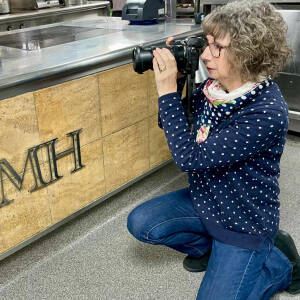Kelmscott Manor - Stairway Selfie
Still feeling rather full from our 'Pudding Club' experience yesterday, see Bom's blip: https://www.blipfoto.com/entry/2228997582342851578
B. and I went to visit the former home of William and Jane Morris (and for a while) Dante Gabriel Rossitti. As huge fans of his designs M. and I are using WM fabric and wallpaper in our new home. So it was very special to actually see where he lived and see many patterns which were new to me. I also had to employ a huge amount of restraint to only spend a little in the gift shop...there were so many tempting things for sale! I think it's wonderful that his beautiful designs are still very popular, and available today.
I have added below some information about the manor.
Kelmscott Manor is a limestone manor house in the Cotswold village of Kelmscott, Oxfordshire. It dates from around 1570, with a late 17th-century wing, and is a Grade I Listed building. It is situated close to the River Thames, and it is frequently flooded.
Kelmscott Manor was the country home of the writer, designer and socialist William Morris from 1871 until his death in 1896. Today it is owned by the Society of Antiquaries of London.
Morris drew great inspiration from the unspoilt authenticity of the house's architecture and craftsmanship, and its organic relationship with its setting, especially its garden. The Manor is featured in Morris' work News From Nowhere. It also appears in the background of Water Willow, a portrait of his wife, Jane Morris , painted by Dante Gabriel Rossetti in 187 1. Jane and Dante Gabriel Rossetti (who also lived at Kelmscott for a while) had an intimate relationship, and Jane is featured in many of Rossetti’s paintings and drawings.
After William Morris's death in 1896, the Manor continued to be occupied by his widow, Jane Morris (who purchased it in 1913) and later, his daughters. May Morris died in 1938 and bequeathed the house to Oxford University, on the basis the contents were preserved and the public were granted access. The University were unwilling to preserve the house as 'a museum piece' and passed the house and land to the Society of Antiquaries in 1962.
The internal decor today is substantially that of Morris, and includes many of his famous textile patterns as well as much of his furniture . There is a display of his textile designs in the converted loft, which would originally have been used for farm labourers. His bedroom contains many of his original books, and a collection of Durer prints. The state of the house is much as it was left by Morris after his death.
(Apologies for lack of comments and stars...I will catch up shortly!)

Comments
Sign in or get an account to comment.


